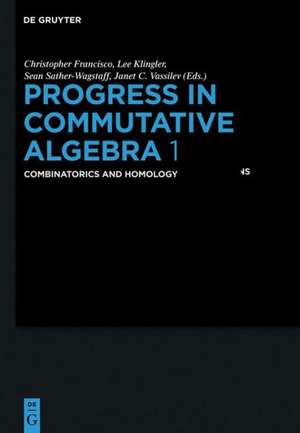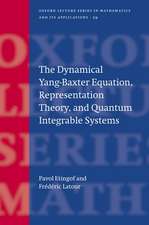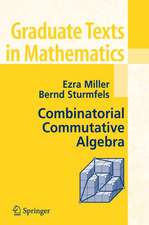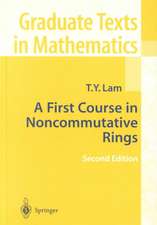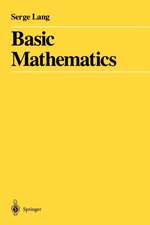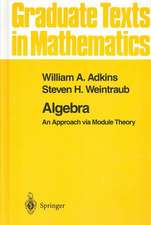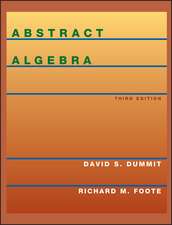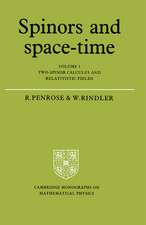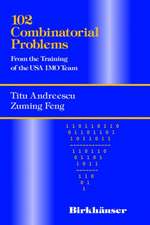Progress in Commutative Algebra 1: Combinatorics and Homology: de Gruyter Proceedings in Mathematics
Contribuţii de Timothy B. P. Clark, Susan M. Cooper, Gunnar Fløystad, Anthony V. Geramita, Brian Harbourne, Livia Hummel, Graham J. Leuschke, Jeff Mermin, Juan C. Migliore, Susan Morey, Paul C. Roberts, Rafael Heraclio Villarreal Rodríguez, Yongwei Yao Editat de Christopher Francisco, Lee C. Klingler, Sean Sather-Wagstaff, Janet C. Vassileven Limba Engleză Hardback – 15 apr 2012
Din seria de Gruyter Proceedings in Mathematics
- 9%
 Preț: 1441.48 lei
Preț: 1441.48 lei - 9%
 Preț: 1629.93 lei
Preț: 1629.93 lei - 23%
 Preț: 1463.94 lei
Preț: 1463.94 lei - 23%
 Preț: 1615.92 lei
Preț: 1615.92 lei - 23%
 Preț: 1385.15 lei
Preț: 1385.15 lei - 23%
 Preț: 1609.09 lei
Preț: 1609.09 lei - 23%
 Preț: 1159.04 lei
Preț: 1159.04 lei - 23%
 Preț: 1462.31 lei
Preț: 1462.31 lei - 23%
 Preț: 854.67 lei
Preț: 854.67 lei - 23%
 Preț: 1462.92 lei
Preț: 1462.92 lei - 23%
 Preț: 2575.58 lei
Preț: 2575.58 lei - 23%
 Preț: 858.24 lei
Preț: 858.24 lei - 23%
 Preț: 1464.87 lei
Preț: 1464.87 lei - 23%
 Preț: 1158.45 lei
Preț: 1158.45 lei - 23%
 Preț: 1469.59 lei
Preț: 1469.59 lei - 23%
 Preț: 2568.33 lei
Preț: 2568.33 lei - 23%
 Preț: 1312.38 lei
Preț: 1312.38 lei - 23%
 Preț: 858.40 lei
Preț: 858.40 lei - 23%
 Preț: 1465.28 lei
Preț: 1465.28 lei - 23%
 Preț: 1239.63 lei
Preț: 1239.63 lei - 9%
 Preț: 4239.36 lei
Preț: 4239.36 lei - 23%
 Preț: 1463.06 lei
Preț: 1463.06 lei - 23%
 Preț: 854.97 lei
Preț: 854.97 lei - 23%
 Preț: 1233.26 lei
Preț: 1233.26 lei - 23%
 Preț: 1543.53 lei
Preț: 1543.53 lei - 23%
 Preț: 1774.76 lei
Preț: 1774.76 lei - 23%
 Preț: 857.79 lei
Preț: 857.79 lei - 23%
 Preț: 937.24 lei
Preț: 937.24 lei - 23%
 Preț: 2075.88 lei
Preț: 2075.88 lei - 23%
 Preț: 1313.12 lei
Preț: 1313.12 lei - 23%
 Preț: 1467.67 lei
Preț: 1467.67 lei - 23%
 Preț: 2350.50 lei
Preț: 2350.50 lei - 23%
 Preț: 1612.81 lei
Preț: 1612.81 lei - 23%
 Preț: 1699.49 lei
Preț: 1699.49 lei - 23%
 Preț: 2130.60 lei
Preț: 2130.60 lei - 23%
 Preț: 1754.82 lei
Preț: 1754.82 lei - 23%
 Preț: 851.58 lei
Preț: 851.58 lei - 23%
 Preț: 1645.40 lei
Preț: 1645.40 lei - 23%
 Preț: 1386.32 lei
Preț: 1386.32 lei - 9%
 Preț: 1213.35 lei
Preț: 1213.35 lei - 23%
 Preț: 1542.20 lei
Preț: 1542.20 lei - 23%
 Preț: 1379.95 lei
Preț: 1379.95 lei - 23%
 Preț: 1682.15 lei
Preț: 1682.15 lei - 23%
 Preț: 1153.10 lei
Preț: 1153.10 lei - 23%
 Preț: 1225.92 lei
Preț: 1225.92 lei - 23%
 Preț: 1644.83 lei
Preț: 1644.83 lei - 23%
 Preț: 1468.85 lei
Preț: 1468.85 lei - 23%
 Preț: 1080.33 lei
Preț: 1080.33 lei - 23%
 Preț: 1463.35 lei
Preț: 1463.35 lei
Preț: 1755.72 lei
Preț vechi: 2280.15 lei
-23% Nou
336.06€ • 365.16$ • 282.48£
Carte tipărită la comandă
Livrare economică 21 aprilie-05 mai
Specificații
ISBN-10: 3110250349
Pagini: 372
Dimensiuni: 170 x 240 x 28 mm
Greutate: 0.75 kg
Editura: De Gruyter
Colecția De Gruyter
Seria de Gruyter Proceedings in Mathematics
Locul publicării:Berlin/Boston
Notă biografică
Cuprins
Preface
1 Boij-Soederberg Theory: Introduction and SurveyGunnar Fløystad1.1 Introduction 1.2 The Boij-Söderberg Conjectures 1.2.1 Resolutions and Betti Diagrams 1.2.2 The Positive Cone of Betti Diagrams 1.2.3 Herzog-Kühl Equations 1.2.4 Pure Resolutions 1.2.5 Linear Combinations of Pure Diagrams 1.2.6 The Boij-Söderberg Conjectures 1.2.7 Algorithmic Interpretation 1.2.8 Geometric Interpretation 1.3 The Exterior Facets of the Boij-Söderberg Fan and their Supporting Hyperplanes 1.3.1 The Exterior Facets 1.3.2 The Supporting Hyperplanes 1.3.3 Pairings of vector Bundles and Resolutions 1.4 The Existence of Pure Free Resolutions and of Vector Bundles with Supernatural Cohomology 1.4.1 The Equivariant Pure Free Resolution 1.4.2 Equivariant Supernatural Bundles 1.4.3 Characteristic Free Supernatural Bundles 1.4.4 The Characteristic Free Pure Resolution 1.4.5 Pure Resolutions Constructed from Generic Matrices 1.5 Cohomology of Vector Bundles on Projective Spaces 1.5.1 Cohomology Tables 1.5.2 The Fan of Cohomology Tables of Vector Bundles 1.5.3 Facet Equations 1.6 Extensions to Non-Cohen-Macaulay Modules and to Coherent Sheaves 1.6.1 Betti Diagrams of Graded Modules in General 1.6.2 Cohomology of Coherent Sheaves 1.7 Further Topics 1.7.1 The Semigroup of Betti Diagrams of Modules 1.7.2 Variants on the Grading 1.7.3 Poset Structures 1.7.4 Computer Packages 1.7.5 Three Basic Problems
2 Hilbert Functions of Fat Point Subschemes of the Plane: the Two-fold WayAnthony V. Geramita, Brian Harbourne, and Juan Migliore2.1 Introduction 2.2 Approach I: Nine Double Points 2.3 Approach I: Points on Cubics 2.4 Approach II: Points on Cubics
3 Edge Ideals: Algebraic and Combinatorial PropertiesSusan Morey and Rafael H. Villarreal3.1 Introduction 3.2 Algebraic and Combinatorial Properties of Edge Ideals 3.3 Invariants of Edge Ideals: Regularity, Projective Dimension, Depth 3.4 Stability of Associated Primes
4 Three Simplicial ResolutionsJeff Mermin4.1 Introduction 4.2 Background and Notation 4.2.1 Algebra 4.2.2 Combinatorics 4.3 The Taylor Resolution 4.4 Simplicial Resolutions 4.5 The Scarf Complex 4.6 The Lyubeznik Resolutions 4.7 Intersections 4.8 Questions
5 A Minimal Poset Resolution of Stable IdealsTimothy B. P. Clark5.1 Introduction 5.2 Poset Resolutions and Stable Ideals 5.3 The Shallability of PN 5.4 The Topology of PN and Properties of D(PN) 5.5 Proof of Theorem 2.4 5.6 A Minimal Cellular Resolution of R/N
6 Subsets of Complete Intersections and the EGH ConjectureSusan M. Cooper6.1 Introduction 6.2 Preliminary Definitions and Results 6.2.1 The Eisenbud-Green-Harris Conjecture and Complete Intersections 6.3 Rectangular Complete Intersections 6.4 Some Key Tools 6.4.1 Pairs of Hilbert Functions and Maximal Growth 6.4.2 Ideals Containing Regular Sequences 6.5 Subsets of Complete Intersections in P2 6.6 Subsets of C.I.(2, d2, d3) with d2 = d3 6.7 Subsets of C.I.(3, d2, d3) with d3 = d2 6.8 An Application: The Cayley-Bacharach Property
7 The Homological ConjecturesPaul C. Roberts7.1 Introduction 7.2 The Serre Multiplicity Conjectures 7.2.1 The Vanishing Conjecture 7.2.2 Gabber's Proof of the Nonnegativity Conjecture 7.2.3 The Positivity Conjecture 7.3 The Peskine-Szpiro Intersection Conjecture 7.3.1 Hochester's Metatheorem 7.4 Generalizations of the Multiplicity Conjectures 7.4.1 The Graded Case 7.4.2 The Generalized Rigidity Conjecture 7.5 The Monomial, Direct Summand, and Canonical Element Conjectures 7.6 Cohen-Macaulay Modules and Algebras 7.6.1 Weakly Functorial Big Cohen-Macaulay Algebras 7.7 The Syzygy Conjecture and the Improved New Intersection Conjecture 7.8 Tight Closure Theory 7.9 The Strong Direct Summand Conjecture 7.10 Almost Cohen-Macaulay Algebras 7.11 A Summary of Open Questions 7.11.1 The Serre Positivity Conjecture 7.11.2 Partial Euler Characteristics 7.11.3 Strong Multiplicity Conjectures 7.11.4 Cohen-Macaulay Modules and Related Conjectures 7.11.5 Almost Cohen-Macaulay Algebras
8 The Compatibility, Independence, and Linear Growth PropertiesYongwei Yao8.1 Introduction 8.2 Primary Decomposition 8.3 Compatibility of Primary Components 8.4 Maximal Primary Components, Independence 8.5 Linear Growth of Primary Components 8.6 Linear growth of {?Tor?_c^R (?(M/(I^m M )),?(N/(J^n N)))} 8.7 Secondary Representation 8.8 Compatibility of Secondary Components 8.9 Applying a Result of Sharp on Artinian Modules 8.10 Independence 8.11 Minimal Secondary Components 8.12 Linear Growth of Secondary Components
9 Recent Progress in Coherent Rings: A Homological PerspectiveLivia Hummel9.1 Introduction 9.2 Coherent Rings and Grade 9.2.1 Coherent Rings and ?(FP)?_?^R Modules 9.2.2 Non-Noetherian Grade 9.3 Cohen-Macaulay Rings 9.4 Gorenstein Dimensions and the Auslander-Bridger Property 9.4.1 Gorenstein Dimenstions 9.4.2 The Auslander-Bridger Formula 9.5 Gorenstein Rings and Injective Dimensions 9.6 Foundations for Coherent Complete Intersections
10 Non-commutative Crepant Resolutions: Scenes from Categorical GeometryGraham J. Leuschke10.1 Introduction 10.2 Morita Equivalence 10.3 (Quasi)coherent Sheaves 10.4 Derived Categories of Modules 10.5 Derived Categories of Sheaves 10.6 Example: Tilting on Projective Space 10.7 The Non-existence of Non-commutative Spaces 10.8 Resolutions of Singularities 10.9 The Minimal Model Program 10.10. Categorical Desingularizations 10.11 Example: the McKay Correspondence 10.12 Non-commutative Crepant Resolutions 10.13 Example: Normalization 10.14 MCM Endomorphism Rings 10.15 Global Dimension of Endomorphism Rings 10.16 Rational Singularities 10.17 Examples: Finite Representation Type 10.18 Example: the Generic Determinant 10.19 Non-commutative Blowups 10.20 Omissions and Open Questions
